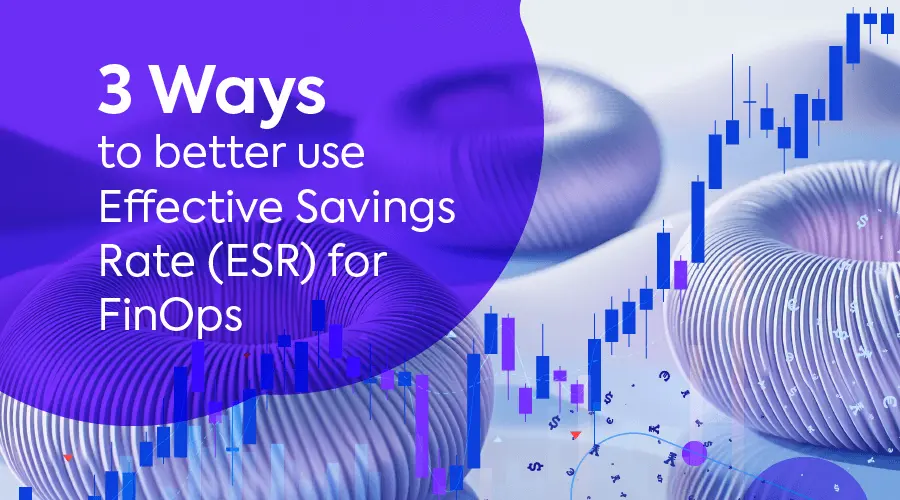
In the realm of FinOps, new concepts emerge all the time. One pivotal metric recently introduced by the FinOps Foundation is the Effective Savings Rate (ESR). ESR measures the savings achieved through various cloud commitment deals, like Reserved Instances (RIs) and Savings Plans (SPs).
This blog discusses how organizations can use the ESR metric while understanding its limitations and how to overcome them.
What is the Effective Savings Rate (ESR)?
Effective Savings Rate (ESR) is a financial metric used to assess the effectiveness of a company’s discounted cloud commitment strategy—namely the way it manages reserved instances (RIs), savings plans (SPs), and other committed usage discounts (CUDs).
ESR is expressed as a percentage, representing the gap between commitment cost and their on-demand equivalent. As it corresponds with actual usage, it indicates not only commitment discount rates, but also the level of commitment utilization. Therefore, using ESR, companies can work towards ensuring they benefit from the maximum cost-saving potential of their cloud commitments.
How to calculate ESR
The ESR formula is based on two parameters used in the FinOps Foundation’s FOCUS™ specification. FOCUS normalizes cloud cost and usage data across all providers and practicing organizations.
- Effective cost: the actual amount spent on commitments, including the proportional amortized cost of future ones.
- Contracted cost: the on-demand equivalent (ODE) of the discounted usage, after contracted discounts (EA, EDP)
ESR (%) = 1- (Effective Cost) / ODE)
3 things to know about ESR
ESR is a useful KPI to calculate the value of commitments. However, to make better use of it, there are some underlying aspects about it that are worth knowing:
#1: Consider the cost of managing your commitments
The FinOps foundation defines ESR as the “ROI for cloud discount instruments”. This means that ESR can measure the cost-efficiency of your commitment management.
However, the “effective cost” in the above formula only represents the commitment cost charged by the cloud provider. As such, it does not include the supplemental costs of managing a commitment portfolio. Management costs might include man-hours spent by the FinOps analyst, DevOps engineer, or IT manager who manages the commitments, or third-party vendor fees.
Luckily, the FinOps Foundation offers another, less-known variation (see “option 2”) which brings commitment management costs into account:
ESR (%) = (savings – cost to achieve savings) / ODE
An interesting exercise would be calculating ESR for the same period with both formulas. The discrepancy is an estimate of your commitment management cost. Next, compare it with team reports on hours spent internally, or with third-party vendor billing.
Pro tip: “Option 2” of the ESR formula can help you compare commitment management alternatives more fairly. For in-house management, consider the engineering hours spent for the given period. For third-party management, consider the vendor fee. For example, NetApp Spot Eco calculates the fee as a percentage of commitment savings it generated.
#2: There are more than just commitments
ESR focuses on commitment savings. In reality, FinOps practitioners use more savings mechanisms than just commitments. This is demonstrated by the scope of the FinOps Foundation’s definition of “rate optimization”. Besides commitments, it also includes:
- Using alternative cloud regions or availability zones (AZs)
- Supporting negotiated discounts that lower the “contracted cost”
- Leveraging spot instances, which offer up to 90% discounts compared to the on-demand equivalent—more than any existing commitment
A metric for calculating the overall effectiveness of rate optimization efforts should include these cost-saving instruments too.
#3: Consider the cost of lock-in
Increased savings—and a higher ESR—are often achieved through larger or longer commitments. However, commitments require financial lock in. Therefore, when presenting the ESR we recommend including the commitment expiration dates to showcase the actual ‘cost’ of achieving this ESR rate.
Wrapping up: How to use ESR in your FinOps practice
ESR is helpful in evaluating the savings impact of cloud commitments. However, it doesn’t tell the whole story of cloud savings, or FinOps which includes management costs, the full spectrum of rate optimization strategies, or commitment lock-in.
Therefore, to tap into its main insights, ESR must be used in context:
- To estimate your commitment management cost, consider the discrepancies between results given by the two ESR formulas.
- Remember that a low ESR may be the result of various considerations: oversized instances or committed usage capacity that result in waste; a lower-saving commitment type; high commitment management costs; or increased usage of spot instances, which reduces commitment coverage but is likely to yield higher savings.
- Alongside ESR, evaluate your level of commitment lock-in, to see if your current strategy fits your business needs, now and in 1-3 years’ time.
- If you aren’t doing so already, explore additional rate reduction instruments which are beyond the ESR’s scope, like spot instances or a wider geographic distribution of instances.
Spot Eco can track and help to improve the ESR. And if used together with NetApp Spot’s broader FinOps portfolio, practitioners can also see ESR in context of their wider FinOps efforts and make the best use of it for informed cloud strategy decisions.

